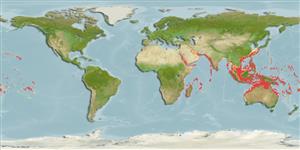Environment: milieu / climate zone / depth range / distribution range
Ecologia
marinhas associadas(os) a recifes; intervalo de profundidade 3 - 150 m (Ref. 9824). Tropical; 32°N - 32°S, 26°E - 138°W
Indo-Pacific: throughout the Indian Ocean, including the Red Sea and the Persian Gulf to Hawaiian, Marquesas, and Society islands, north to southern Japan, south to Lord Howe Island. Record from the eastern Mediterranean incorrect (Ref. 9824).
Tamanho / Peso / Idade
Maturity: Lm ? range ? - ? cm
Max length : 39.0 cm TL macho/indeterminado; (Ref. 9710); common length : 20.0 cm TL macho/indeterminado; (Ref. 3322)
Espinhos dorsais (total) : 0; Raios dorsais moles (total) : 84 - 97; Espinhos anais: 0; Raios anais moles: 61 - 73. Eyed side with dark spots, blotches and rings on body and median fins; 1 distinct dark blotch on middle of straight section of lateral line; narrow dark crossbars on eyed side of pectorals (Ref. 4417). Pectoral rays 9-12 (eyed side) and 9-11 (blind side).
Inhabits sandy or silty sand, and muddy bottoms of inner reef flats and seaward reefs; juveniles frequently found in tide pools (Ref. 9824, 48637). Benthic (Ref. 58302). Feeds on benthic animals (Ref. 5213). Utilized as a food fish (Ref. 4537) and processed into fish meal (Ref. 9824).
Life cycle and mating behavior
Maturidade | Reprodução | Desova | Ovos | Fecundidade | Larvas
Hensley, D.A., 1986. Bothidae. p. 854-863. In M.M. Smith and P.C. Heemstra (eds.) Smiths' sea fishes. Springer-Verlag, Berlin. (Ref. 4417)
Categoria na Lista Vermelha da IUCN (Ref. 130435: Version 2024-1)
Ameaça para o homem
Harmless
Utilização humana
Pescarias: espécies comerciais
Ferramentas
Relatórios especiais
Descarregue XML
Fontes da internet
Estimates based on models
Preferred temperature (Ref.
123201): 18.6 - 28.3, mean 25.1 °C (based on 608 cells).
Phylogenetic diversity index (Ref.
82804): PD
50 = 0.5000 [Uniqueness, from 0.5 = low to 2.0 = high].
Bayesian length-weight: a=0.00891 (0.00474 - 0.01676), b=3.11 (2.95 - 3.27), in cm total length, based on LWR estimates for this species & Genus-body shape (Ref.
93245).
Nível Trófico (Ref.
69278): 3.5 ±0.37 se; based on food items.
Resiliência (Ref.
120179): Baixo, tempo mínimo de duplicação da população 4,5 - 14 anos (Preliminary K or Fecundity.).
Prior r = 0.25, 95% CL = 0.17 - 0.38, Based on 1 data-limited stock assessment.
Fishing Vulnerability (Ref.
59153): Low to moderate vulnerability (29 of 100).
Climate Vulnerability (Ref.
125649): Moderate vulnerability (44 of 100).
Nutrients (Ref.
124155): Calcium = 40 [16, 81] mg/100g; Iron = 0.462 [0.219, 0.857] mg/100g; Protein = 18.1 [16.6, 19.6] %; Omega3 = 0.0809 [, ] g/100g; Selenium = 41.3 [21.5, 84.8] μg/100g; VitaminA = 63.4 [16.2, 259.7] μg/100g; Zinc = 0.993 [0.659, 1.434] mg/100g (wet weight);
